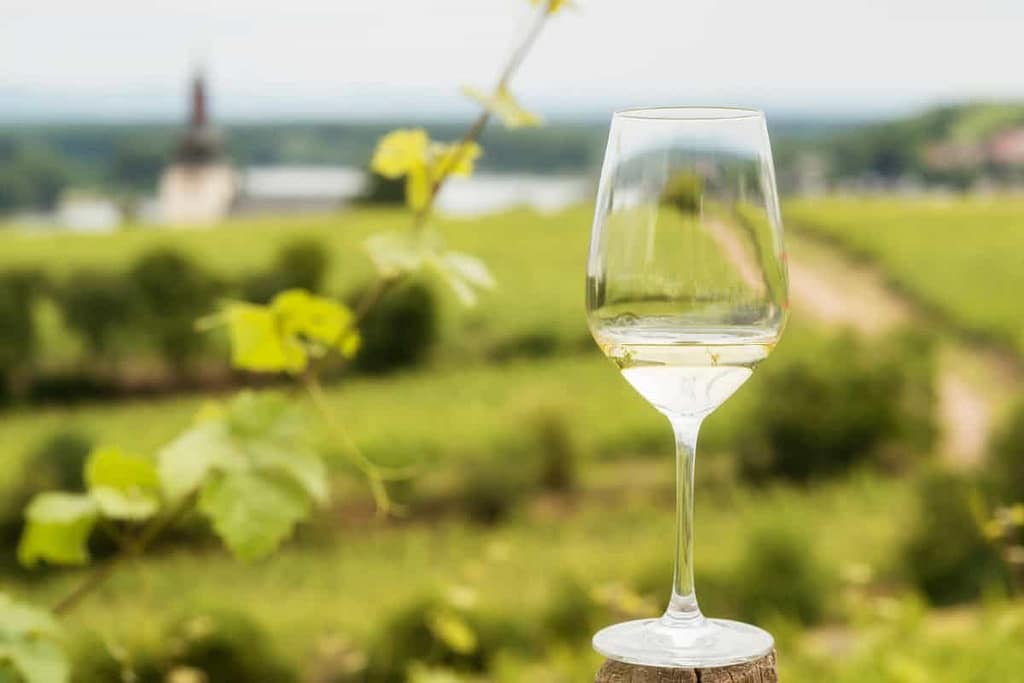Dry White Wine Types: A Quick Guide for Wine Lovers
When you think about dry white wines, you probably picture refreshing, crisp flavors that are perfect for light meals and warm weather. Pinot Grigio and Sauvignon Blanc are popular choices for a reason; they offer bright acidity and a clean finish that pairs well with a variety of dishes.

From seafood to chicken dishes, dry white wines can enhance the flavors and enjoyment of your meals.
Grapes like Chenin Blanc and Grüner Veltliner produce some of the best dry white wines, known for their high acidity and complex flavor profiles. These wines often come from cooler climates, like the Loire Valley in France or New Zealand, where the grapes develop rich aromas and bright fruit notes.
You might taste hints of tropical fruits, stone fruits, or even bell pepper, making each sip an adventure.
If you’re looking for something unique, try an unoaked Chardonnay or a dry Riesling. These wines offer different experiences, from the light and crisp to the aromatic and flavorful.
Whether you’re a seasoned wine lover or just starting out, exploring the various types of dry white wines can be a lot of fun and definitely worth your time.
Understanding Dry White Wines
Dry white wines are a popular choice for many due to their crispness and lower sugar content. We’ll explore how dryness is achieved and the balance between sugar and acidity in these wines.
The Science of Dryness
Dryness in white wine means there’s little to no residual sugar. During the fermentation process, yeast converts grape sugar into alcohol. If this process continues until most of the sugar is gone, the wine becomes dry. For example, Pinot Grigio and Sauvignon Blanc are well-known for their bone-dry characteristics.
Dry wines often come from cooler climates like New Zealand or Southern France. These regions produce grapes with high acidity, another factor that contributes to the dry taste. A good dry white wine typically has fewer than 4 grams of sugar per liter.

Sugar and Acidity Balance
Balancing sugar and acidity is crucial for creating enjoyable dry white wines. The acidity in these wines helps to balance the little residual sugar left after fermentation, giving them a crisp, refreshing taste. Wines like Chenin Blanc and dry Riesling from the Loire Valley are great examples of this balance.
Acidity also plays a key role in food pairings. A glass of dry white wine works well with seafood dishes or lighter meals that have cream sauces. High acidity cuts through the richness of these dishes, creating a perfect harmony of flavors. This balance is why dry white wines are versatile and popular choices for many palates.
Popular Varieties of Dry White Wine
Discovering the best dry white wines can be a fun journey. You’ll find options ranging from light and crisp to bold and aromatic, suitable for various dishes and occasions.
Chardonnay: The Versatile Choice
Chardonnay is known for its versatility. It can range from light and crisp to rich and full-bodied. The flavors can include green apple, pear, and sometimes even tropical fruits like pineapple or mango. You might also find notes of stone fruit, especially if the wine is aged in oak barrels.
This grape is grown worldwide, from the cooler climates of Burgundy, France, to the sunny vineyards of California. Depending on the region and winemaking process, the alcohol content and body can vary. It’s a popular choice for those who enjoy cooked meals like seafood dishes and chicken dishes with cream sauces.

Sauvignon Blanc: Crisp and Aromatic
Sauvignon Blanc is a top pick for its crisp acidity and refreshing taste. Often associated with the Loire Valley and Bordeaux region in France, it boasts herbal notes and bell pepper. New Zealand is another famous region, producing wines with strong tropical fruit characteristics.
This dry wine is usually light-bodied, making it ideal for summer. Its high acidity pairs well with lighter dishes such as salads, seafood, and goat cheese. It’s also a great way to enjoy a simple glass of wine with friends.
Riesling: The Aromatic Spectrum
Riesling can cover a wide range of flavors, from dry to sweet wines. The best dry Rieslings often come from Germany, Washington State, and Australia. These wines are known for their high acidity and aromatic notes, including green apple, citrus, and even hints of petrol in aged wines.
Despite its reputation for sweeter wine, dry Riesling is a fantastic option when looking for something with little residual sugar. Its bright acidity pairs well with a variety of dishes, particularly Asian cuisine and spicier foods. This grape variety is excellent for those who enjoy a balanced, fruity wine without too much sugar.

Pairing Dry White Wines with Food
Dry white wines can be a great match for many different foods. From seafood to cheese, these wines have versatile flavor profiles that enhance your dining experience.
Seafood Combinations
Dry white wines like Sauvignon Blanc and Unoaked Chardonnay are excellent with seafood. The high acidity of these wines cuts through the natural oils of fish and shellfish. Try pairing Pinot Grigio with a lemony shrimp dish, or a light Riesling with crab cakes. The crispness of these wines also works well with grilled fish seasoned with herbs.
Cheese and Wine Harmony
A good dry white wine can enhance the flavors of many kinds of cheese. Chenin Blanc from the Loire Valley pairs well with tangy goat cheese. Grüner Veltliner, with its herbal notes, goes nicely with** nutty cheeses** like Gruyère and Gouda. The key is to match the wine’s acidity levels to the cheese’s richness for a balanced taste.
Fruit Accents in Pairing
Fruit flavors in wines can complement many dishes. Riesling with hints of green apple and citrus pairs beautifully with dishes featuring fruit accents, like a chicken salad with nectarines. A cool glass of Pinot Blanc is refreshing with a picnic spread that includes fresh fruits and light snacks. For a unique combo, try Sauvignon Blanc with a salad of stone fruit and greens.

Regions Known for Dry White Wine
Certain regions around the world are famous for producing excellent dry white wines. These areas have unique climates and traditions that make their wines special.
Europe’s Finest: Loire and Burgundy
The Loire Valley in France is famous for its elegant Sauvignon Blanc and Chenin Blanc. The cool climate helps in creating wines with high acidity and crisp flavors like green apple and citrus.
Burgundy, especially Chablis, is known for its unoaked Chardonnay. The limestone soil and cool temperatures result in a clean, mineral taste that pairs well with a variety of dishes.
Italy also excels with Pinot Grigio from regions like Friuli and Veneto. These wines are light and easy to drink, often showing notes of apple and pear.
Spain and Portugal offer great examples too. Try Albariño from Rías Baixas in Spain for its bright acidity and stone fruit flavors.
Austria’s Grüner Veltliner brings peppery, herbal notes to the table. This versatile wine goes well with lighter dishes and seafood.

New World Wonders: California to Australia
California‘s Napa Valley and Sonoma are well-known for producing Chardonnay and Sauvignon Blanc. The warm climate and varied soils offer fruity flavors with balanced acidity.
Oregon is another standout for Pinot Gris. The cooler climate results in wines with a fresh, clean profile that includes tropical fruits and stone fruits.
New Zealand is celebrated for its bright and zesty Sauvignon Blanc. Regions like Marlborough focus on vibrant flavors like bell pepper and tropical fruit.
Australia brings Riesling from the Clare and Eden Valleys. These dry styles showcase lime and mineral notes that are refreshing.
Finally, South Africa offers distinctive Chenin Blanc and Sauvignon Blanc with unique herbal and fruity flavors. The Mediterranean climate helps in producing wines with good acidity and fresh flavors.
Selecting and Storing Dry White Wines
When selecting and storing dry white wines, it’s crucial to understand key details on the wine label and best storage practices for keeping the wine fresh.
Decoding Labels: ABV and Descriptors
Labels on wine bottles convey important details. The Alcohol by Volume (ABV) indicates the wine’s strength. For dry whites like Pinot Grigio, Sauvignon Blanc, and Chenin Blanc, the ABV often ranges from 12% to 14%.
Look for descriptors like “crisp,” “mineral,” or “bright acidity” to identify a wine’s taste. Terms such as “unoaked” suggest less influence of oak on flavor. Understanding these clues helps you pick the right wine for your taste and dish.

Storage Tips for Optimal Freshness
Store your dry white wines in a cool, dark place. Ideal storage temperature is between 45°F and 55°F. Keep the bottles on their sides to prevent the cork from drying out.
Avoid storing wine in areas with frequent temperature changes. For longer storage, a wine fridge is a good investment. Refrigerate opened bottles and consume within a few days to maintain the wine’s freshness and bright flavor.
Frequently Asked Questions
Dry white wines come in many varieties and are perfect for cooking, pairing with foods, and enjoying on their own. Here, we answer some common questions about selecting and using these wines.
What are some top choices for dry white wines to use in recipes?
Dry white wines that work well in recipes include Sauvignon Blanc, Pinot Grigio, and Chenin Blanc. These wines add a fresh, zesty flavor to dishes. Dry Vermouth is another option for cooking. It has a hint of herbal notes and pairs nicely with seafood dishes and cream sauces.
How can one choose the right dry white wine when shopping?
When choosing a dry white wine, check the wine label for terms like “dry” or “crisp acidity”. Look for regions known for quality dry whites, like the Loire Valley, New Zealand, or South Africa. Make sure to consider your food pairings and the wine’s flavor profile.
Which dry white wine would be a good pick for a light summer dish?
For light summer dishes, Sauvignon Blanc or Grüner Veltliner are excellent choices. These wines are light-bodied with crisp acidity, making them ideal for salads, seafood, and dishes with tropical fruits or stone fruit flavors.
Can you suggest a dry white wine as an alternative to Chardonnay?
If you usually enjoy Chardonnay but want to try something different, consider Unoaked Chardonnay, Pinot Grigio, or Grenache Blanc. These wines provide a similar dry taste without the oak influence, offering a clean, refreshing flavor.
What characteristics differentiate various dry white wines?
Dry white wines can vary based on the grape variety, fermentation process, and region. For example, Pinot Grigio is light and crisp, while Chenin Blanc often has high acidity and can show notes of tropical fruits or stone fruit. Sauvignon Blanc may showcase herbal notes like bell pepper.
Are there any notable differences between Pinot Grigio and Sauvignon Blanc in terms of dryness?
Pinot Grigio and Sauvignon Blanc are both dry, but they have distinct differences.
Pinot Grigio is typically lighter with a crisp taste and flavors of green apple or white peach.
Sauvignon Blanc often has a bolder flavor profile with herbal notes, higher acidity, and sometimes hints of tropical fruits.






